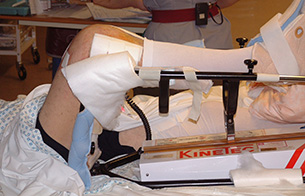
A continuous passive motion (CPM) machine in use after total knee replacement surgery.
The operation of knee replacement begins well before admission, usually at a preadmission clinic. Here basic blood tests are performed, heart tracings undertaken, and further details given to a patient as to what can be expected during and after surgery.
Admission is normally either the day before, or on the day of surgery. Surgery itself may be performed under general or local anaesthetic. The surgical team will most likely operate in a strictly clean environment, often an operating theatre with a specially designed airflow. What counts is the number of air changes per hour. The more the air changes, the greater the sterility. A normal operating theatre will have 10-12 air changes in an hour. A proper orthopaedic theatre can have up to 40 per hour, while special, ultraclean airflows are associated with 3-400 air changes per hour. These are ideal. Antibiotic cover is normally given during surgery - it is belt and braces as far as infection avoidance is concerned at knee replacement.
Once the patient is suitably prepared and positioned, the skin is cleaned with an antibacterial solution and then draped accordingly. An incision is then made over the front of the knee and the patella pushed to one side (it will be put back later!) so that the lower femur and upper tibia can be identified. Then using special instruments called jigs the surgeon will cut the ends of the bones with a powerful saw, shaping them so they precisely fit the artificial knee components. Eventually, when the cuts are as exact as can be obtained, trial components are positioned. These are components that allow accurate sizing and positioning but which are not designed to be left inside a patient. Once the trials have been seen to fit, so the surgeon can insert the definitive knee replacement, with or without cement, depending on the design chosen. The patella is replaced, the skin closed, and a dressing applied. Drains may also have been inserted to release any blood that accumulates after the operation. They are usually left in for a maximum of 48 hours.
Once back on the ward, there is little time to rest - it is hard work being a patient! Physiotherapy and exercise is essential to a good result after knee replacement. Sometimes exercise is helped by the use of a continuous passive motion machine (CPM), a device that automatically bends and straightens the knee joint even when a patient is asleep. By five days post-operatively, most patients should be able to actively bend their knee to about 70-90 degrees, sometimes more. It is then time to go home, although the range of movement is likely to improve further as the days and weeks go by. Most knee replacements will ultimately bend to about 110 degrees when recovery is complete but a specific range of movement after surgery is very difficult for any surgeon to guarantee.
Consequently, a likely timetable for an uncomplicated knee replacement is approximately as follows:
Three weeks before surgery |
|
Pre-operative assessment clinic |
Day 0 |
|
Admission and surgery |
Day 1 |
|
Drains out, patient up |
Day 2 |
|
Check X-Ray, post-operative blood tests, further exercise |
Day 3 & 4 |
|
Rehabilitation continues |
Day 5 |
|
Discharge home, outpatient physiotherapy continues |
Six weeks |
|
Off walking support. Pre-operative restrictions end |
Please remember that pre- and post-operative regimes vary widely. If you do not adhere to the above timetable it does not mean you are being handled incorrectly. Do discuss matters with your surgeon.
